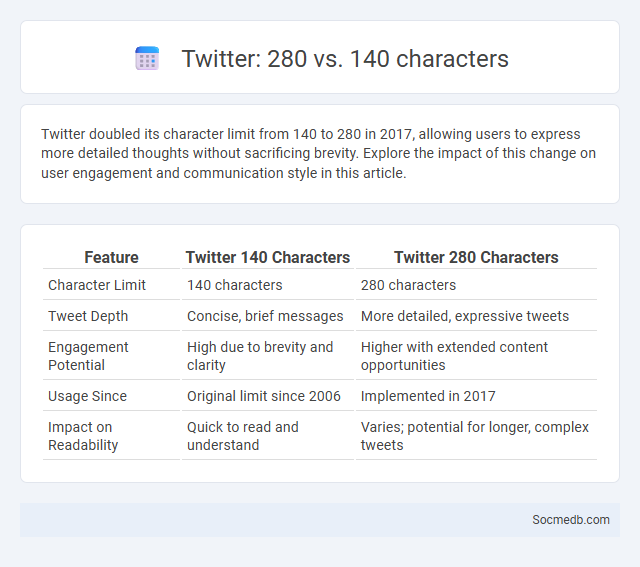
Photo illustration: Twitter 280 vs 140 characters
Twitter doubled its character limit from 140 to 280 in 2017, allowing users to express more detailed thoughts without sacrificing brevity. Explore the impact of this change on user engagement and communication style in this article.
Table of Comparison
| Feature | Twitter 140 Characters | Twitter 280 Characters |
|---|---|---|
| Character Limit | 140 characters | 280 characters |
| Tweet Depth | Concise, brief messages | More detailed, expressive tweets |
| Engagement Potential | High due to brevity and clarity | Higher with extended content opportunities |
| Usage Since | Original limit since 2006 | Implemented in 2017 |
| Impact on Readability | Quick to read and understand | Varies; potential for longer, complex tweets |
Introduction: Evolution of Twitter’s Character Limit
Twitter revolutionized microblogging by initially limiting posts to 140 characters, reflecting SMS constraints. This character cap shaped concise communication and user creativity on the platform. In 2017, Twitter doubled the limit to 280 characters, accommodating more expressive content and enhancing user engagement while preserving brevity.
Twitter’s Original 140 Characters: Pros and Cons
Twitter's original 140-character limit fostered concise communication, encouraging users to share clear and impactful messages quickly. This brevity boosted creativity and engagement, making your tweets easily scannable and shareable. However, the constraint sometimes restricted depth, limiting nuanced discussions and detailed explanations within a single tweet.
The Shift to 280 Characters: Rationale and Impact
Twitter's shift from 140 to 280 characters was driven by the need to enhance user expression without sacrificing brevity, allowing You to convey more detailed thoughts in a single tweet. This change significantly increased engagement rates and content richness, while maintaining the platform's core value of concise communication. Marketers and social media strategists adapted quickly, leveraging the extended limit to create more impactful and informative messaging.
User Engagement: 140 vs 280 Characters
User engagement on social media significantly varies between 140 and 280 character limits, with the shorter 140-character format driving higher interaction rates due to its concise and easily digestible content. Tweets limited to 140 characters often result in more retweets and replies, fostering quicker communication and stronger audience connection. Expanding to 280 characters allows for more detailed messaging but may reduce engagement as users prefer brief posts for faster consumption.
Content Depth: How Longer Tweets Change Conversations
Longer tweets provide more space for detailed thoughts, enabling users to share nuanced insights and foster richer discussions on social media platforms. By expanding character limits, users can engage in deeper conversations without fragmenting their messages, enhancing clarity and promoting meaningful interactions. Your social media presence benefits from this increased content depth, encouraging followers to participate in more substantial and informed exchanges.
Trending Topics: Influence of Character Limits
Character limits on social media platforms like Twitter shape the nature of trending topics by encouraging concise and impactful messaging, driving users to prioritize clarity and creativity. These restrictions foster rapid information sharing and amplify viral content, influencing public discourse and real-time engagement. As a result, character constraints play a crucial role in determining which topics gain traction and how narratives evolve across digital communities.
Hashtags and Virality: Character Count Effects
Hashtags play a crucial role in enhancing social media visibility, directly influencing content virality by categorizing posts and increasing discoverability. Optimal hashtag length typically ranges from 10 to 25 characters, balancing clarity and keyword relevance to boost engagement rates. Research indicates that posts with concise, well-targeted hashtags achieve higher shares and impressions, accelerating viral reach on platforms like Instagram and Twitter.
Marketers’ Perspective: Best Practices for 140 vs 280
Marketers optimize social media impact by tailoring content length to platform limits, with 140-character posts driving concise, engagement-focused messages while 280 characters allow more detailed storytelling. Your strategy should leverage brevity to boost immediate reactions and clarity, ensuring brand voice remains clear and compelling. Effective use of hashtags, clear calls-to-action, and audience-focused language enhances reach and conversion, maximizing marketing ROI across varying character constraints.
Analytics: Data on Engagement and Reach
Social media analytics provide critical data on engagement metrics such as likes, comments, shares, and click-through rates, enabling marketers to gauge audience interaction and content effectiveness. Reach data quantifies the total number of unique users exposed to posts, offering insights into brand visibility and campaign penetration. Advanced tools utilize this data to optimize posting schedules, target demographics, and content strategies for maximum impact.
Future Trends: Character Limits and Twitter’s Direction
Twitter is evolving by experimenting with extended character limits, shifting beyond its original 280-character constraint to facilitate more nuanced conversations. The platform is investing in multimedia integration and spaces for audio interactions, aligning with user demand for richer, interactive content. These changes indicate Twitter's strategic direction toward becoming a more comprehensive social media ecosystem that balances brevity with depth.
 socmedb.com
socmedb.com